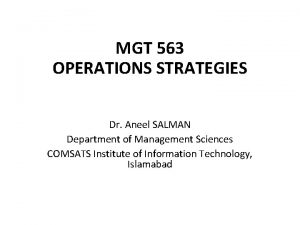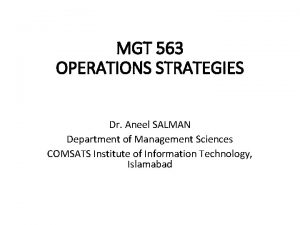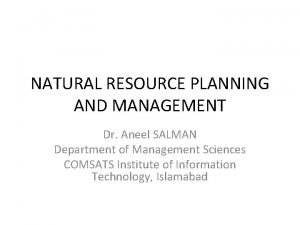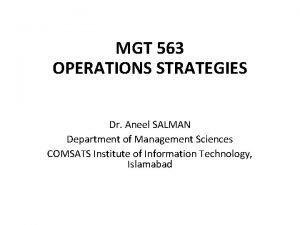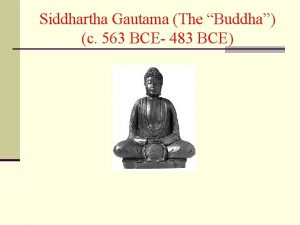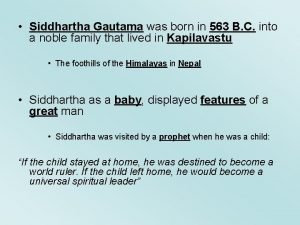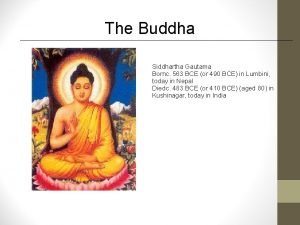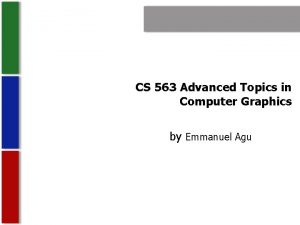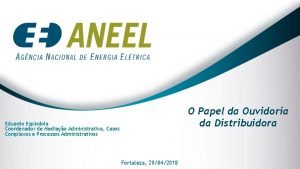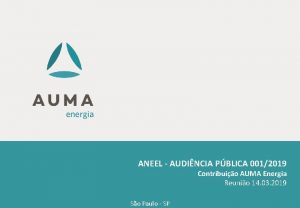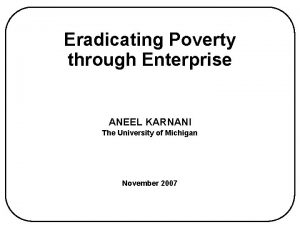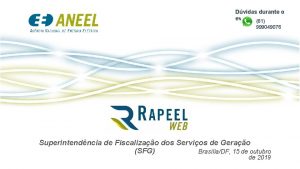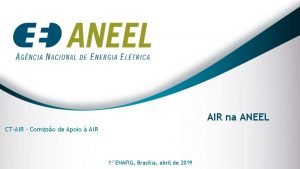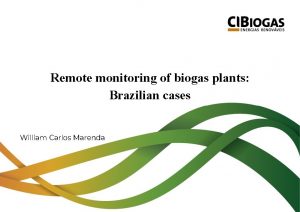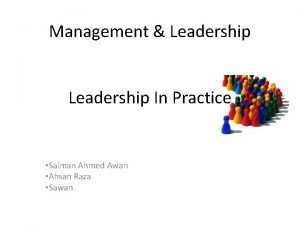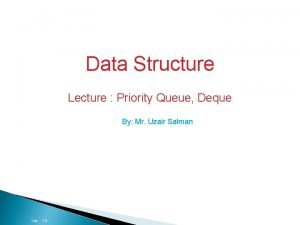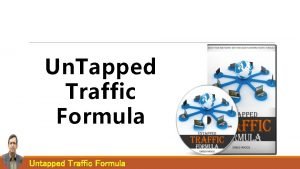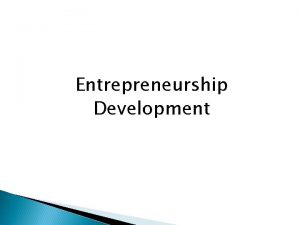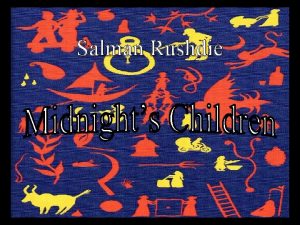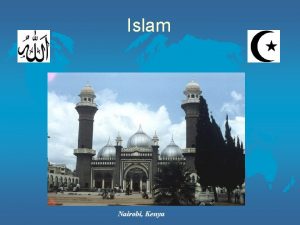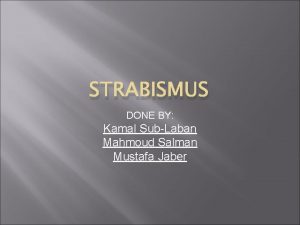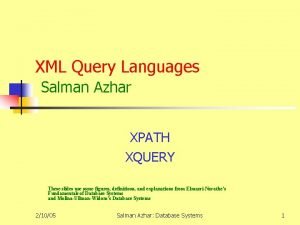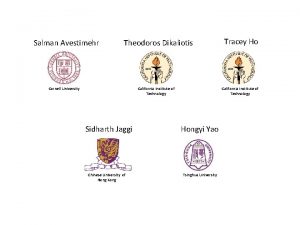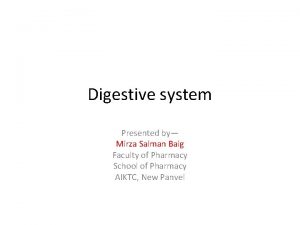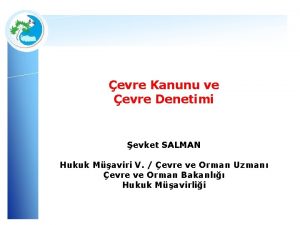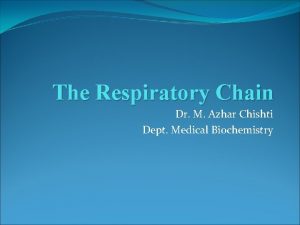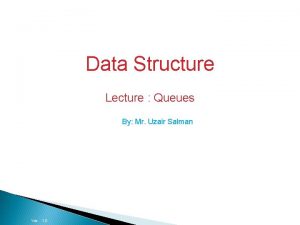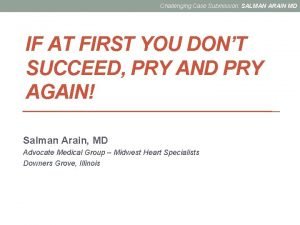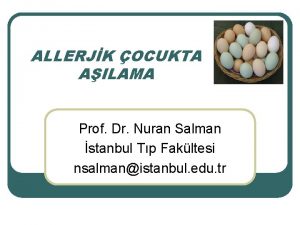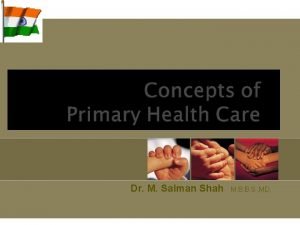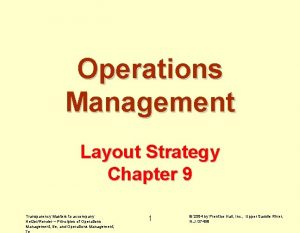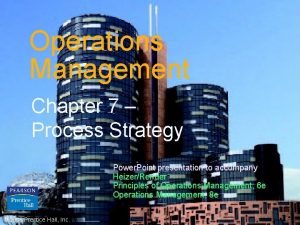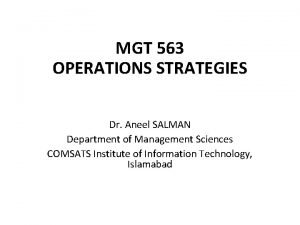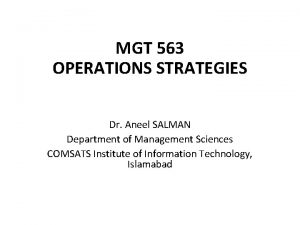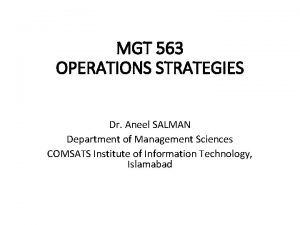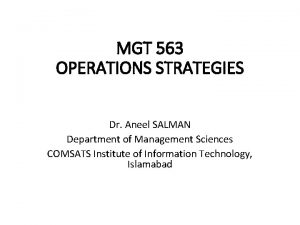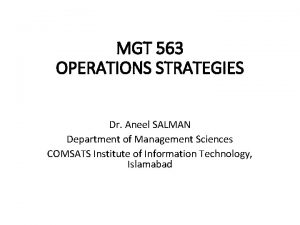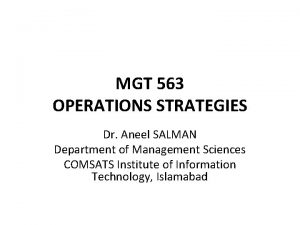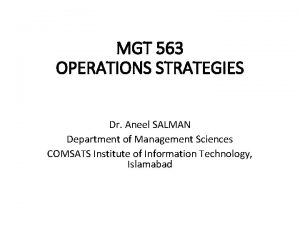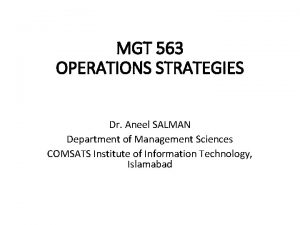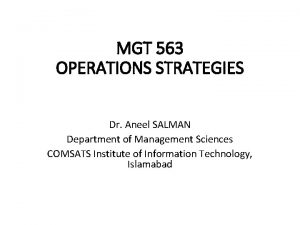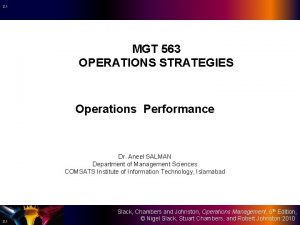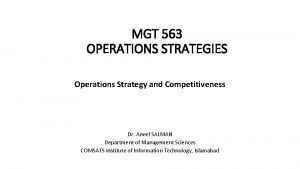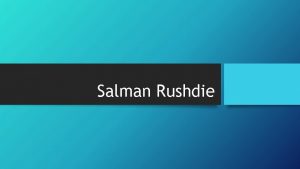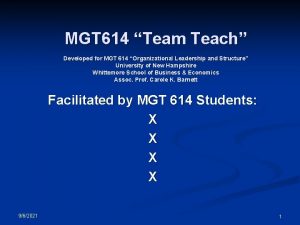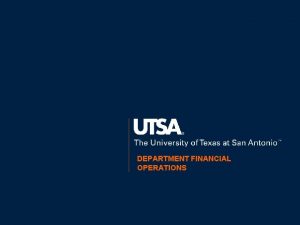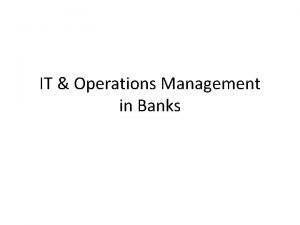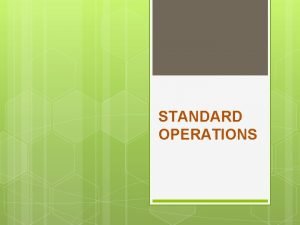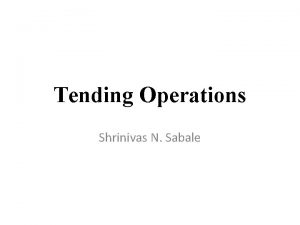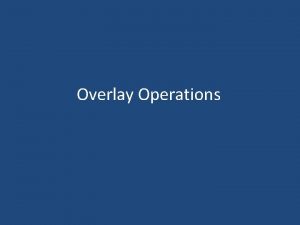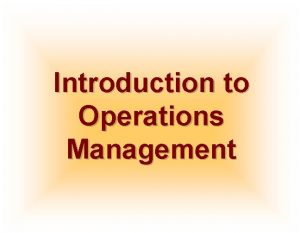MGT 563 OPERATIONS STRATEGIES Dr Aneel SALMAN Department





































- Slides: 37

MGT 563 OPERATIONS STRATEGIES Dr. Aneel SALMAN Department of Management Sciences COMSATS Institute of Information Technology, Islamabad

Recap Lecture 27 • Human Resource Management • Human Resource Functions • Dynamic Human Resource Management Environment • HR’s Changing Role

Human Resource Designations

Human Resource Executives, Generalists, and Specialists Vice President, Human Resources Manager, Compensation Benefits Analyst Vice President, Industrial Relations Manager, Training and Development Manager, Staffing Executive: Generalist: Specialist:

Characteristics of an HR Executive • Performs one or more HR functions • A top-level manager • Reports directly to CEO or head of major division

Characteristics of an HR Generalist • Often an executive • Performs tasks in various HR related areas • Involved in several, or all, of the five HRM functions

Characteristics of an HR Specialist • May be an HR executive, manager, or non-manager • Typically concerned with only one of the five functional areas

Strategic Human Resource Management • Involves development of consistent, aligned collection of practices, programs, & policies to facilitate achievement of strategic objectives • Requires abandoning mindset & practices of “personnel management” & focusing on strategic issues rather than operational issues • Integration of all HR programs within larger framework, facilitating mission & objectives • Writing down strategy facilitates involvement & buy-in of senior executives & other employees

Possible Roles Assumed by HR Function

HR Roles in Knowledge-Based Economy • Human capital steward – Creates an environment & culture in which employees voluntarily contribute skills, ideas, & energy – Human capital is not “owned” by organization • Knowledge facilitator – Procures necessary employee knowledge & skill sets that allow information to be acquired, developed, & disseminated – Provides a competitive advantage – Must be part of strategically designed employee development plan

HR Roles in Knowledge-Based Economy • Relationship builder – Develops structure, work practices, & culture that allow individuals to work together – Develops networks that focus on strategic objectives • Rapid deployment specialist – Creates fluid & adaptable structure & systems – Global, knowledge-based economy mandates flexibility & culture that embraces change

SHRM Critical Competencies • HR’s success as true strategic business partner dependent on five specific competencies: – Strategic contribution - development of strategy – Business knowledge - understanding nuts & bolts of organization – Personal credibility - measurable value demonstrated in programs & policies – HR delivery - serving internal customers through effective & efficient programs – HR technology - using technology to improve organization’s management of people

Lepak & Snell’s Employment Models

Traditional HR Versus Strategic HR

Barriers to Strategic HR • • • Strategic contribution Business knowledge Personal credibility HR delivery HR technology

Outcomes of Strategic HR

Exhibit 4 -8 Model of Strategic HR Management

Strategic HR as Organizational Learning • Stages of knowledge management – Generating or capturing knowledge – Structuring & providing value to gathered knowledge – Transferring knowledge – Establishing mechanisms for use & reuse of knowledge for individuals & groups

Knowledge Management Cycle

Knowledge Management

Strategic HR as Organizational Learning • Knowledge creation – Single loop learning: • Comparing consequences of actions with desired outcomes • Modifying behavior – Double loop learning: • Goes beyond detection & correction of errors • Entails examining actions & outcomes as well as underlying assumptions

Strategic HR as Organizational Learning • Without purposeful analysis of underlying assumptions & systems, organizations may become victims of ‘competency traps’ • Organizational learning: – Inherently rare – Inimitable – Immobile

Strategic HR as Organizational Learning • How HR management systems can contribute to development of organizational knowledge – Labor markets can be exploited in order to attract & select individuals with high cognitive abilities – Internal labor markets can contribute to development of firm specific assets – Cross-functional & inter-organizational teams can be utilized

Strategic HR as Organizational Learning • How HR systems can support & enhance knowledge transfer – Apprenticeship & mentoring – Cross-functional teams – Stimulate & reward information sharing – Provide free access to information – Job rotations

Knowledge Institutionalization • Walsh & Ungson’s five ‘storage bins’ in which organizational memory can reside – Individuals (assumptions, beliefs, & cause maps) – Culture (stories, myths, & symbols) – Transformations (work design, processes, & routines) – Structure (organizational design) – Ecology (physical structure & information systems) • Institutionalized knowledge tends to be firm specific, socially complex, & causally ambiguous

Alternative Orientations of Fit in SHRM

Understanding HRM-Performance Linkages • Scholars have often assumed two perspectives • Systems view considers overall configuration or aggregation of HRM practices • Strategic perspective examines “fit” between various HRM practices & organization’s competitive strategy • Overall set of HRM practices generally associated with firm performance & competitive advantage

Understanding HRM-Performance Linkages • Psychological climate: – Experiential-based perception of what people “see” & report happening to them as they make sense of their environment • Climate: – Critical mediating construct in exploring multilevel relationships between HRM & organizational performance

Understanding HRM-Performance Linkages • Two interrelated features of HRM system: – Content – Process – Must be integrated effectively

Understanding HRM-Performance Linkages • Content – Set of practices adopted – Ideally driven by strategic goals & values – No single most appropriate set of practices for particular strategic objective – Different sets of practices may be equally effective so long as they allow particular type of climate around some strategic objective to develop • Process – How HRM system can be designed & administered effectively by defining meta-features of overall HRM system

Understanding HRM-Performance Linkages • To create strong situations with unambiguous messages about appropriate behavior, HRM systems should have: – Distinctiveness – Consistency – Consensus

Understanding HRM-Performance Linkages • Distinctiveness – Visibility • Degree to which practices are salient & readily observable – Understandability • Lack of ambiguity & ease of comprehension of practice content – Legitimacy of authority • Leads individuals to submit to performance expectations as formally sanctioned behaviors – Relevance • Whether situation is defined so that individuals see it as relevant to important goal

Understanding HRM-Performance Linkages • Consistency – Instrumentality • Unambiguous perceived cause-effect relationship between system’s desired content-focused behaviors & associated employee consequences – Validity • HRM practices must display consistency between what they purport to do & what they actually do

Understanding HRM-Performance Linkages • Consensus – Agreement among message senders – Fairness • Composite of employees’ perceptions of whether practices adhere to three dimensions of justice: distributive, procedural, & interactional

Organization Culture – How is performance defined, measured & rewarded? – How are information & resources allocated & managed? – What is operational philosophy of organization with regard to risk-taking, leadership, & concern for overall results? – Does organization regard human resources as costs or assets?

Interpreting Results & Formulating Strategies • Tendency to try to identify an “ideal” culture • Not clear than any one culture will be effective for all organizations • Strategy consists of interrelated functional components that must be carefully integrated to form an effective whole: – Selection & staffing – Organizational & human resource development – Rewards

Analyzing Dysfunctional Cultures • Which components of culture are misaligned? • What priorities should be assigned to bridging gaps between what culture is & what people feel it should be? • What resources are needed & how should they be used to change culture? • How should change effort be managed & who does what? • What role should HR strategy play in signaling, making & reinforcing necessary changes?
 Aneel salman
Aneel salman Aneel salman
Aneel salman Aneel salman
Aneel salman Management is goal oriented process
Management is goal oriented process Siddharta gautama
Siddharta gautama 563 bc
563 bc 563 bce
563 bce Cs 563 uiuc
Cs 563 uiuc Pd&i
Pd&i Aneel
Aneel Qrt aneel
Qrt aneel Audincia
Audincia Aneel karnani
Aneel karnani Duto net aneel
Duto net aneel Aneel
Aneel Aneel
Aneel Maralfalfa seed
Maralfalfa seed Iasc aneel
Iasc aneel Salman ahmad awan
Salman ahmad awan Deque salman
Deque salman Salman baig seo
Salman baig seo Entrepre meaning
Entrepre meaning Ahmed salman rushdie
Ahmed salman rushdie Salman rudhdie
Salman rudhdie Sinan salman
Sinan salman Salman mustafa
Salman mustafa Salman azhar
Salman azhar Salman avestimehr
Salman avestimehr Mirza salman baig
Mirza salman baig Salman hukuk
Salman hukuk Salman azhar
Salman azhar Deque salman
Deque salman Salman arain md
Salman arain md Nuran salman
Nuran salman Dr muhammad salman
Dr muhammad salman Implementing strategies: management and operations issues
Implementing strategies: management and operations issues Product-oriented layout example
Product-oriented layout example Crossover charts
Crossover charts
